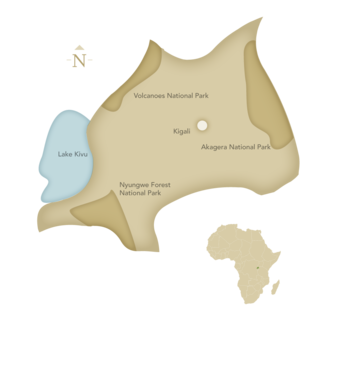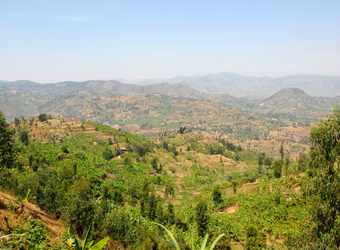Rwanda
| Read Reviews | Write a Review Start Planning Your Custom Safari
 view larger image
view larger image
While Rwanda has seen tremendous tragedy, this small country is also a place of immense beauty and continued healing. An important part of its revival is its wildlife ecotourism, centered on the rare and remarkable mountain gorilla that lives in the dense forests of the volcanic Virungas range in the northwest. About a third of the world’s approximately 1,004 remaining mountains gorillas live in Rwanda. Your visit to their natural habitat may be the only hope for their future. A once-in-a-lifetime encounter with the rare mountain gorilla will surely change your life—and it may well save theirs.
Read About the Different Regions and Parks in Rwanda

Our Expert Says
When you travel in Rwanda, you are indeed a traveler and not a tourist. Few people venture here, and the locals are friendly and welcoming. While sitting in a bamboo forest as a big male silverback gorilla slowly approached our group, I was on the end wearing an orange hair band. Obviously curious about this bright orange accessory, he came over and gently touched my hair, taking a good look. I guess he decided it wouldn’t look good on him, so he ambled off to keep watch over his family. That experience was one of the most moving in my life, and I still think about it daily.
– Wendy Klausner
 view image gallery
view image gallery
Rwanda Safari Highlights
“In the heart of Central Africa, so high up that you shiver more than you sweat," wrote primatologist Dian Fossey, "are great, old volcanoes towering up almost 15,000 feet, and nearly covered with rich, green rainforest—the Virungas." On Rwanda’s western border with Congo, Volcanoes National Park encompasses the slopes of these ancient peaks where Fossey studied the famous “Gorillas in the Mist.” It is one of Africa’s oldest parks, established in 1925 expressly to protect the mountain gorilla. Trekking from cultivated foothills into vine-tangled depths in search of these magnificent creatures is not just a safari highlight, but a high point of a lifetime. To sit and match a gaze with the contemplative eyes of a huge silverback is one of the most poignant wildlife encounters on the planet. You are also sure to see chattering monkeys and melodic birds, and you may spy a giant forest hog or bushbuck.
 view image gallery
view image gallery
Rwanda Wildlife
Rwanda’s tapestry of habitats is home to a diversity of species including mountain gorilla, chimpanzee, golden monkey, hippo giraffe, zebra, leopard, crocodile and more than 600 species of birds. Ten percent of Rwanda is designated as Important Birding Areas. Plains and lakes dominate the eastern borders while Rwanda’s western mountains are draped in forest. This mosaic of montane ecosystems in Volcanoes National Park—bamboo and woodland forest, heath and swamp—is where the mountain gorilla lives, along with 12 other species of primates. Ten habituated gorilla groups are open to tourist visits, with a maximum of 8 visitors to each group for a one-hour period per day. Nearly 200 of Rwanda’s bird species are also found within the park including 29 endemics, as well as giant forest hog, warthog, bush pig, forest elephant, buffalo, bushbuck, waterbuck, black-fronted duiker, spotted hyena, civet, genet, mongoose and tree hyrax.
 view image gallery
view image gallery
Quick Rwanda Facts
Called the Land of a Thousand Hills, Rwanda is a tiny country at the geographic heart of Africa bordering Burundi, the Democratic Republic of the Congo, Uganda and Tanzania. Just over 10,000 square miles, Rwanda is slightly smaller than the state of Maryland yet has 11 million people, the most densely populated country in Africa. Its capital, Kigali, is home to about 1 million. Rwandans are young, predominantly rural and employed mostly In subsistence agriculture. Rwanda gained independence from Belgium in 1962. Its politics have long been colored by conflicts between the nation's two dominant ethnic groups, Hutus and Tutsi. Rwanda is still recovering from aftermath of a civil war that culminated in the 1994 genocide in which more than 800,000 people, mostly Tutsis, were killed. Despite its travails, Rwanda is a positive, peaceable country today. Tourism is Rwanda’s primary foreign exchange earner, and minerals have recently overtaken coffee and tea as the top export.
 view image gallery
view image gallery
Conservation in Rwanda
Rwanda faces great challenges in conserving its heavily taxed natural resources, especially dwindling habitat for its highly endangered mountain gorillas. Yet Rwanda has managed to make progress despite pressures from overpopulation, poverty and political instability. While deforestation, erosion and poaching remain major problems, President Kagame, a committed environmentalist, understands the value of intact ecosystems, and Rwanda is working on re-forestation and maintaining biodiversity. The government’s goal is to re-establish the forest cover that once covered 1/3 of the country. Central to that effort is assisting local communities by planting pines in buffer zones to harvest for firewood, learning to identify and sell medicinal plants, and creating jobs in ecotourism. Rwanda is also involved in important cross-border conservation policy with Uganda and Congo, and the largest remaining block of mountain forest in East Africa, the Nyungwe-Kibira Landscape, a contiguous protected area shared with Burundi that shelters a variety of endangered primates including chimpanzees.
